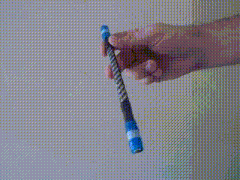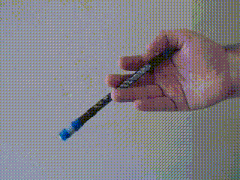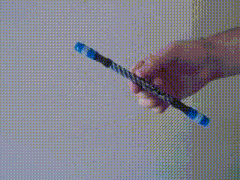Pen spinning
The term pin turning on English Penspinning (also Pentrix or Pentricks ) and Japaneseペン回しpen mawashi called, refers to the turning of a pin with your fingers or hand.
Since penspinning can be done practically anywhere and on almost any occasion, it is particularly widespread among school and university students and is preferably used in class.
Pen turning is similar to bar turning , except that the pen is much smaller than a bar. Since the pin like the fingers normally does not leave the bar turning, this falls under the contact juggling (ger .: contact juggling ). In contrast to bar turning, pen turning requires a lot more sensitivity, which does not have to be present from the start, but rather develops a lot in the course of training. There is also more freedom for tricks when turning the pen.
origin
The first major pen spinning website was founded by the Japanese Dodeaki Kondoh. Fernando Kuo, who lives in the USA and is known as "Kam" among pen spinners, is often associated with the development of pen spinning in its current form. The UPSB (Universal Pen Spinning Board) he founded was also the first major international platform on the subject of pen spinning and ultimately laid the foundation for the establishment of further pen spinning forums in numerous countries.
With him there was also the Legendary 4, which contributed a lot to the spread of penspinning. Together they laid the foundation for everything that is now understood by the term "PenSpinning". The Legendary 4 consist of David Weis, Kam, Tholz and NHK.
equipment
In simple terms, all you need is any pen. However, when it comes to pen thickness, length, shape, and weight, there are many differences with a huge selection on the market. Ink killers are particularly suitable for beginners , as they are almost always built according to the same principle. Furthermore, ink killers are well balanced and have an adequate length. It is easier to "spin" if you attach two grips (rubber grips from other pens, e.g. ballpoint pens) to the ends of the ink killer. Pencils and wooden pens in general are, according to common opinion, too light and you don't have enough feeling in your hand with them.
Advanced users modify the pens with parts from other pens or other parts that are not intended for use. Parts are glued on, replaced, filed or even melted on. The purpose of the modification is usually to shift the focus of the pen, to increase the momentum ( moment of inertia ) or to simply design the pen in terms of shape and color. Very often only “grips” are attached to the ends because it is cheap and quick to do. Another possibility for simple modification is represented by “tips”. “Tips” are the metal parts at the writing end of a pen, for modification purposes they are simply attached or glued. But there are also some pens that represent real works of art in which a modder ( English. Modify, remodel ) the pen is particularly beautiful, for example with an inlay or outlay ( English insert , or a paper that you can place inside or outside of the pen) and decorated the pen in other colors. Some pens also have different grips so that you have a better grip.
Tricks
There are many different tricks in pen spinning and there are almost endless possibilities for inventing new ones. The Thumbaround , the Sonic , the Fingerpass , the Charge and partly also the Infinity are considered basic tricks ( basics ) and the basis for further tricks . Individual tricks can also be combined into so-called “ combos ”, whereby the tricks ideally merge completely smoothly and thus have a high show effect, i.e. are particularly beautiful to look at. There are many well-known combos, but in the end, combos are one of the freestyle tricks because there are so many variations. Beginners especially have their difficulties with the necessary fine motor skills .
- "Aerial" tricks are tricks in which the pen is no longer in the hand, but in the air. The most famous aerial trick is the "Thumbaround Release". The pen is simply thrown up while the pen goes around the thumb. You should then catch the pen "Palm Down" (palm facing away from you).
- In around tricks, the pen is rotated around one finger. The best known is the ThumbAround (English "around the thumb"), in which the pen is rotated around the thumb.
With around tricks there is always a reverse variant, in which the pen is rotated in the opposite direction. There are also "inverse" tricks in which the trick is performed on the other side of the hand. Furthermore, there are always different degrees of variation where the pen is either rotated several times around the finger or where it is first rotated several times on the palm and then picked up again.
With thumb, index, middle, ring, pinkyarounds (around the thumb, index finger, middle finger, ring finger, little finger) there is also the option of performing them fingerless (abbreviation: fl; without finger). To do this, the hand is moved in such a way that the pen rotates around the affected finger without the intervention of another finger.
- The pass is one of the easy tricks. Many people do this trick unconsciously. The most famous pass is the finger pass , which is already a combo of individual passes . The pen is passed from one finger to the next. While this is one of the easiest tricks, the difficulty lies in perfecting this trick.
- In Sonic tricks it comes that the pin changes the position by means of a sweeping turn. In most cases, all fingers except the thumb are used. Again, there is always a reverse variant.
- When charging , the pen is rotated between two fingers.
- The Infinity takes its name from its movement, as this like a figure eight, so a infinity sign ( lemniscate ), looks (ger .: infinity ).
It is often erroneously claimed that infinity tricks are those that can be continued indefinitely as they return to their starting position. This is also the case with the Infinity trick, but the tricks that can be performed continuously are given the addition of continuous .
- Some basic tricks
Individual evidence
- ↑ Archived copy ( Memento of the original from September 4, 2011 in the Internet Archive ) Info: The archive link was inserted automatically and has not yet been checked. Please check the original and archive link according to the instructions and then remove this notice.







